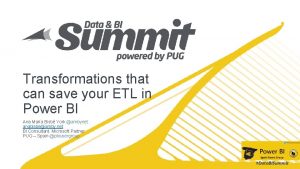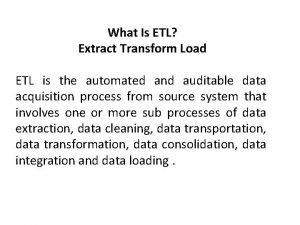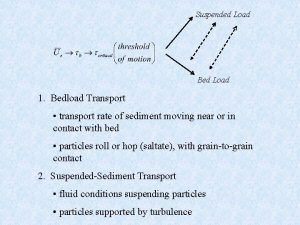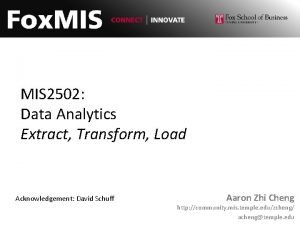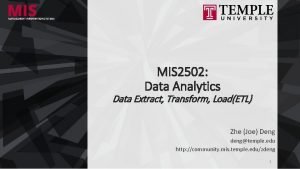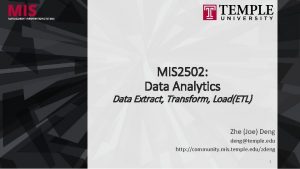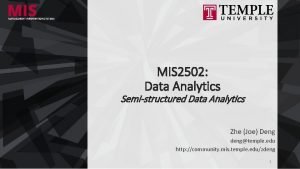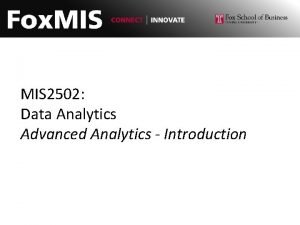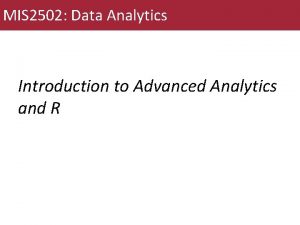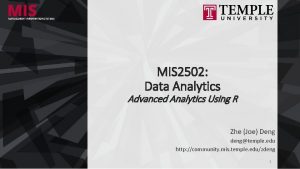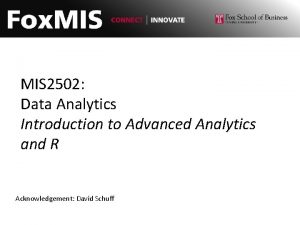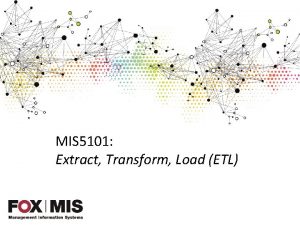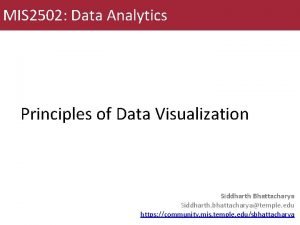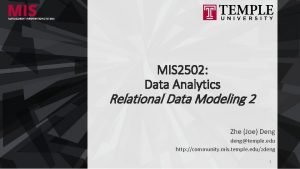MIS 2502 Data Analytics Extract Transform Load Jae















- Slides: 15

MIS 2502: Data Analytics Extract, Transform, Load Jae. Hwuen Jung jaejung@temple. edu http: //community. mis. temple. edu/jaejung

Where we are… Now we’re here… Data entry Data extraction Data analysis Transactional Database Analytical Data Stores real-time transactional data in a relational or No. SQL database Stores historical transactional and summary data

Extract, Transform, Load (ETL) Extract data from the transactional database Transform data into an analysisready format Load it into the analytical data store

The Actual Process Extract Transactional Database 1 Transform Load Data conversion Transactional Database 2 Data conversion Other Sources Data conversion Analytical Data store

ETL’s Not That Easy! Data Consistency • What if the data is in different formats? Data Quality • How do we know it’s correct? • What if there is missing data? • What if the data we need isn’t there?

Data Consistency: The Problem with Legacy Systems • An IT infrastructure evolves over time • Systems are created and acquired by different people using different specifications This can happen through: • • Changes in management Mergers & Acquisitions Externally mandated standards Generally poor planning

Why Not Replacing Legacy Systems? Too much risk Prohibitive cost Limited business agility User reluctance Speed of delivery https: //www. onbase. com/~/media/Files/hyland/whitepaper/wp_trou ble-with-legacy-systems. pdf https: //thenextweb. com/finance/2017/04/10/ancientprogramming-language-cobol-can-make-you-bank-literally/

Problems with Data Consistency The same data element stored in different formats Redundant data across the organization • Social Security number (123 -456789 versus 123456789) • Date (10/9/2020 versus 9/10/2020) • Customer record maintained by accounts receivable and marketing Different naming conventions Different unique identifiers used • “Management Information Systems” versus “MIS” versus “Man. Info. Sys. ” • Access. Net account versus Temple ID

What’s the big deal? This is a fundamental problem for creating the analytical data store We often need to combine information from several transactional databases How do we know if we’re talking about the same customer or product?

Now think about this scenario Hotel Reservation Database Café Database What are the differences between a “guest” and a “customer”? Is there any way to know if a customer of the café is staying at the hotel?

Solution: “Single view” of data • The entire organization understands a unit of data in the same way • It’s both a business goal and a technology goal but it’s really more this… . . . than this

Closer look at the Guest/Customer Guests Guest_number Guest_firstname Guest_lastname Guest_address Guest_city Guest_zipcode Guest_email vs. Customer_number Customer_name Customer_address Customer_city Customer_zipcode Getting to a “single view” of data: How would you represent “name? ” What would you How do you figure use to uniquely Would you include out if you’re identify a email address? talking about the guest/customer? same person?

Data Transformation Steps Parsing Correcting Standardizing Matching • Decomposes data elements • Example: [name: Joe Cool ]→[First. Name: Joe, Last. Name: Cool) • Corrects parsed data elements • Example: street name does not exist and is replaced with the "closest" one • Transforms data into its preferred format • Example: Broad ST → Broad Street • Matches records within and across data sources

Data Quality The degree to which the data reflects the actual environment • Choose data consistent with the goals of analysis Do we have the right data? • Manual verification through sampling • Use the knowledge expert Is the data accurate? • Verify that the data really measures what it claims to measure Is the collection process reliable? • Build fault tolerance into the process • Periodically run reports, check logs, and verify results

Summary • What is ETL? Why is it important? – Data consistency – Data quality • Explain the purpose of each component (Extract, Transform, Load)
 Power bi extract transform load
Power bi extract transform load Extract transform and load automation
Extract transform and load automation Clasificacion del derecho
Clasificacion del derecho Usaf promotion afi
Usaf promotion afi Jae dong noh
Jae dong noh Jae in assembly language
Jae in assembly language Jump instruction in 8086
Jump instruction in 8086 Cmp in assembly language
Cmp in assembly language Jae lee columbia
Jae lee columbia Omer boyaci
Omer boyaci Jae booklet 2019
Jae booklet 2019 Bearing
Bearing Tributary load and load path
Tributary load and load path Bed load and suspended load transport
Bed load and suspended load transport Dc load line definition
Dc load line definition Teramond
Teramond
